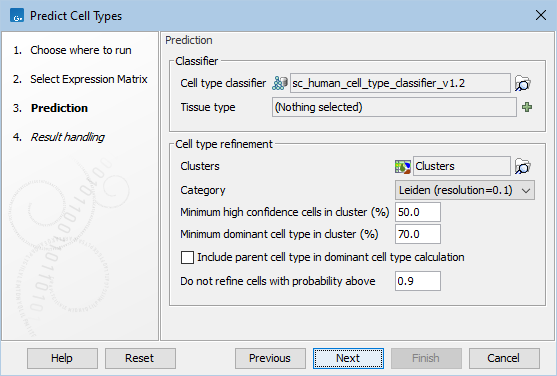Predict Cell Types
Predict Cell Types uses a Cell Type Classifier (Predict Cell Types is available from:
Tools | Single Cell Analysis (![]() ) | Gene Expression (
) | Gene Expression (![]() ) | Cell Type Classification (
) | Cell Type Classification (![]() ) | Predict Cell Types (
) | Predict Cell Types (![]() )
)
There are a number of options that can be adjusted (figure 8.2).

Figure 8.2: Options for Predict Cell Types. A Cell Type Classifier for human data downloaded from the Reference Data Manager has been selected.
Under `Classifier':
- Cell type classifier. A classifier downloaded from the Reference Data Manager or produced by Train Cell Type Classifier.
Note that the features in the input matrix and those used for training the classifier should be matching, see Features used for training and prediction.
- Tissue type. Many cell types from the QIAGEN Cell Ontology are associated with specific tissues. When one or more tissues are selected, cell types associated with other tissues will no longer be predicted. For example, hepatocytes are associated with the liver. If Tissue type = Heart, then no cells will be predicted as "hepatocytes". A list of cell types that would have been predicted had no tissue type been specified can be found on the History view (
 ) of the outputs.
) of the outputs.
Under `Cell type refinement', the cell type can optionally be refined (see Cell type refinement):
- Clusters (Optional). A Cell Clusters element containing clusters for the input matrix.
- Category (Optional). The category from the Cell Clusters element which contains the clusters for cell type refinement.
- Minimum high confidence cells in cluster (%) (Optional). Cell type refinement for high confidence cell types (see The output of Predict Cell Types) is only performed for clusters where the percentage of cells that have a predicted high confidence cell type is larger than or equal to this.
- Minimum dominant cell type in cluster (%) (Optional). Cell type refinement is only performed for clusters where the percentage of cells that have the dominant cell type, i.e. the most frequent cell type, is larger than or equal to this.
- Include parent cell type in dominant cell type calculation (Optional). When enabled, cell type refinement for clusters where the percentage of cells that have the dominant cell type is lower than `Minimum dominant cell type in cluster (%)', will be performed using the dominant parent cell type from the QIAGEN Cell Ontology, if its percentage is larger than or equal to Minimum dominant cell type in cluster (%).
- Do not refine cells with probability above. Cell type refinement is only applied to cells for which the probability of the predicted cell type is equal to or below this. When set to 1.0, cell type refinement will be used for all cells.
Note that for Tissue type and Include parent cell type in dominant cell type calculation to have an effect, cell types need to be from the QIAGEN Cell Ontology, see The Cell Type Classifier element.
Subsections
